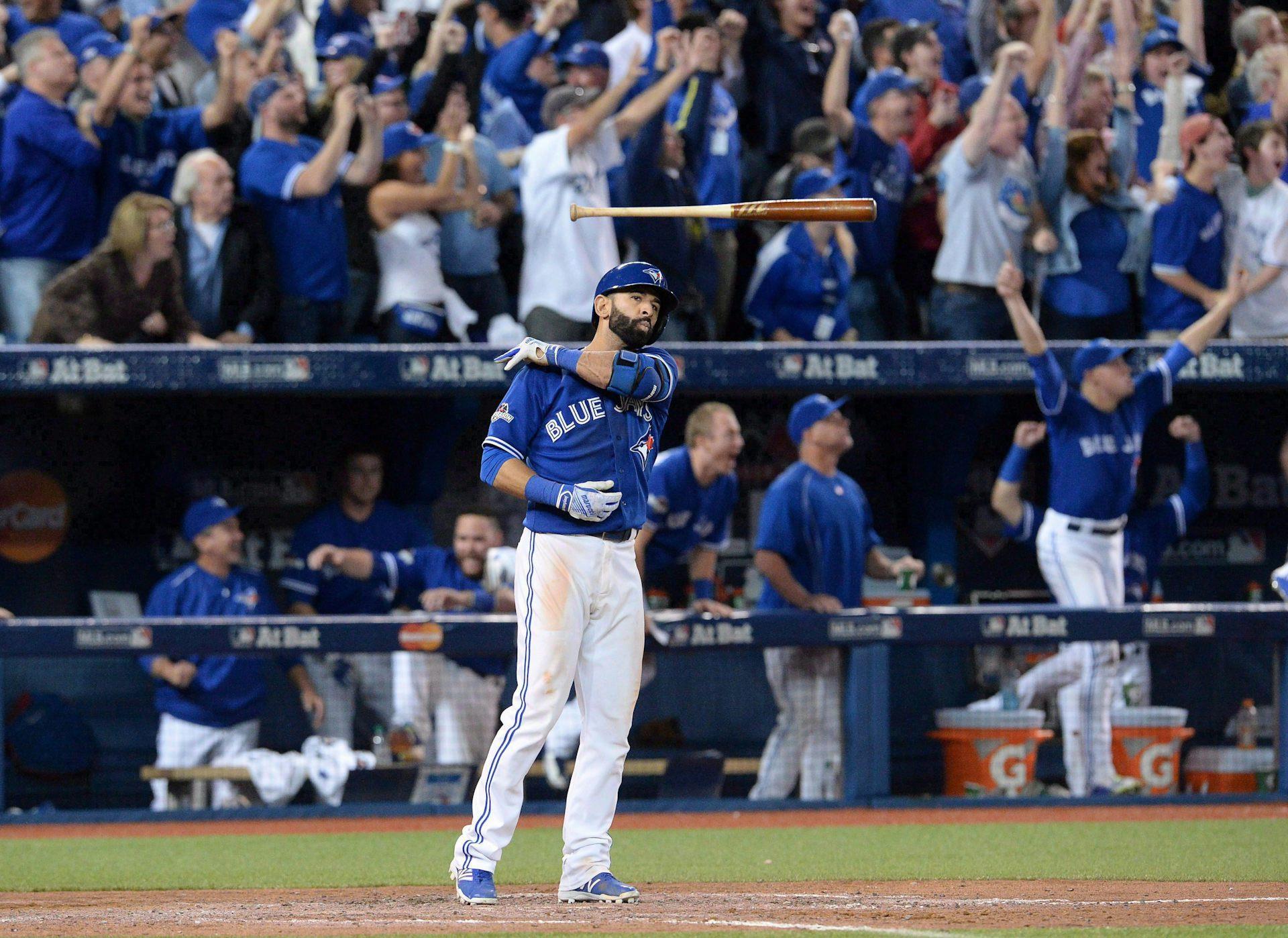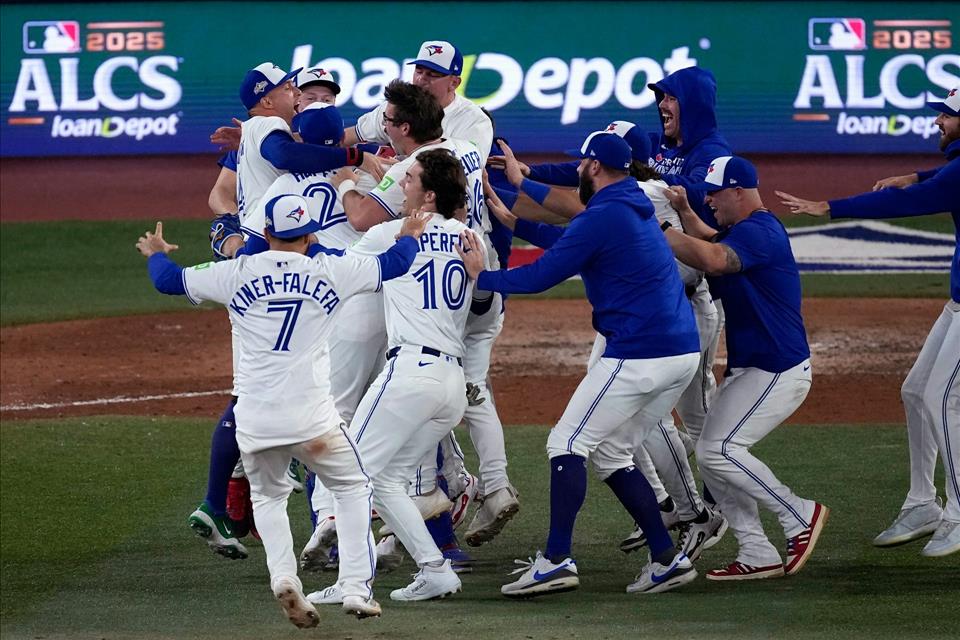
Blue Jays Fever Sets In As Canada Readies For The World Series For The First Time In 32 Years
Six outs later, the Blue Jays had qualified for the 2025 World Series against the defending champion Los Angeles Dodgers.
It had the feeling of a denouement. Yet, like other famed home runs in Blue Jays history, Springer's blast was just one step in the long journey through baseball's three playoff rounds.
Edwin Encarnacion's extra-inning walk-off homer against the Baltimore Orioles in 2016 only won an elimination wildcard game.
A year earlier, Jose Bautista's then-audacious bat flip followed a dramatic home run - also like Springer's hit in the seventh inning - that moved the Blue Jays onto the same championship series round that they had not won since 1993. Until this year.

Toronto Blue Jays' Jose Bautista flips his bat after hitting a three-run homer during seventh inning of Game 5 of the American League Division Series in Toronto in 2015. THE CANADIAN PRESS/Chris Young The enduring legacy of 1993
Invoking 1993 holds special resonance for Blue Jays fans. It's the last time the team won, let alone reached, the World Series.
That year produced the most dramatic home run in team history. Joe Carter's Game 6, ninth-inning, three-run blast to left field was only the second time a World Series had ended with a walk-off home run. It clinched the team's second straight championship.
It is easy to tell the story of the Blue Jays through the lens of dramatic game-winning home runs. However, the context of the team's championships -and near misses - offers a more nuanced tale.
Toronto Blue Jay Joe Carter celebrates his game-winning, three-run home run in the ninth inning of Game 6 of the World Series in Toronto in 1993. (AP Photo/Mark Duncan) Building a contending team
Toronto, thanks to funding from Labatt Breweries, was granted an American League expansion franchise in 1977, alongside the Seattle Mariners - the team Toronto just vanquished in the championship series this year. The Mariners remain the only current franchise never to have played in a World Series.
Following a handful of dire losing seasons, Blue Jays management earned a reputation for talent development. The first crop of stars - Dave Stieb, George Bell and Tony Fernandez - won a division championship in the team's ninth season. They fell one game short of qualifying for the World Series, losing the only seventh game in a post-season series in franchise history prior to this year.
That team played in an open-air, refurbished football stadium. Fans chilled by the cool breezes off Lake Ontario did not enjoy the irony of cheering on their brewery-owned team in a venue where beer sales were prohibited by provincial edict.
Toronto's SkyDome in 1996. When it opened in 1989, the park was the envy of the baseball world - a state-of-the-art facility that continually packed in more than 50,000 fans a game. THE CANADIAN PRESS/Scott MacDonald
Modernity came to Toronto in 1989 when the team moved into SkyDome, a then-state-of the-art domed stadium complete with retractable roof (and by then, beer vendors) that was funded and operated by a public-private partnership.
A U.S. marine honour guard flies the Canadian flag upside down during Game 2 of the 1992 World Series in Atlanta, Georgia, in 1992. THE CANADIAN PRESS/Hans Deryk
After playoff disappointments in 1989 and 1991, that generation of Blue Jays stars broke through in 1992 to reach the World Series for the first time. Prior to the second game at Atlanta's Fulton County Stadium, the U.S. Marine Corps colour guard walked onto the field with the Canadian flag flying upside down.
The controversy was integrated into circulating narratives that Americans did not respect Canadian teams. It is a still-perpetuated trope: the Toronto Star has spent this playoff run reporting on“what the U.S. media said” about Blue Jays' victories, as though that matters.
The Blue Jays 2025 success - realizing the promise of a new generation of star prospects headlined by Vladimir Guererro Jr. and Bo Bichette - has rekindled memories of these past glories: the first winning teams of the 1980s, the back-to-back champions in 1992-93 and the bravado of the Bautista-Encarnacion-Josh Donaldson teams from a decade ago.
Lost in this pantheon of star players and dramatic moments, however, is the two decades of mediocrity that followed the heights of the Carter home run.
Changes in corporate ownershipThe Blue Jays core aged or moved on and Labatt's was purchased by the Belgian conglomerate, Interbrew SA.
A more dispassionate, bottom-line ownership led to teams that failed to reap the talents of Hall of Famers like Roy Halladay and major stars like Carlos Delgado and Shawn Green.
Rogers Communications purchased 80 per cent of the Blue Jays in 2000, with Interbrew retaining 20 per cent. The on-field performance changed little, but the business model evolved significantly.
Rogers acquired the remaining 20 per cent of the team in July 2004. Before the year was out, it had gained control of SkyDome for $25 million, a fraction of the $600 million that the stadium has cost to build only 15 years earlier. Now fully privately owned, it was renamed the Rogers Centre.
Today, the Blue Jays reflect the vertical integration of modern commercial sports. The team is the primary tenant in a stadium operated by their owners. Their games are broadcast on television channels, radio stations and streaming services owned and operated by Rogers Communications. These channels market other Rogers-owned content during Blue Jays games.
Meanwhile, fans consume this content on cable subscriptions and internet services that are Rogers' core businesses. The newest extension of this revenue-generation model is the increasing prominence of sports betting, which is integrated fully into broadcasts by on-screen commentators providing odds as though delivering sports“news,” not paid advertising
Canada's teamThe production and circulation of dominant narratives is a consequence of such a structure, what sociologist David Whitson termed “circuits of promotion.”
One of the most powerful is that the support for the Blue Jays is nationwide. They are Canada's team. There is an element of truth to this. The Blue Jays' fan base is considerable, particularly when they are winning.
Toronto Blue Jays' George Springer connects for a three-run home run against the Seattle Mariners during the seventh inning in Game 7 of the American League Championship Series, on Oct. 20, 2025, in Toronto. (AP Photo/David J. Phillip)
But this is also a marketing construct - one that benefits from the Blue Jays being the only remaining Canadian-based team in a U.S.-operated professional sports league. This would be a much harder narrative to sell if the Montreal Expos were not now the Washington Nationals, and it is not entirely novel.
Read more: Toronto Blue Jays: Amid Canada-U.S. tensions, 'Canada's team' is excelling at America's pastime
Basketball's Toronto Raptors, themselves the beneficiaries of the relocation of the Vancouver Grizzlies, capitalized on both the team's appeal as well as its monopoly on Canadian markets with its wildly popular 2019 marketing campaign,“We The North.”
Come Friday night, when Trey Yesavage throws the first pitch of the 2025 World Series, the absence of other Canadian-based teams and the centralization of media outlets in Toronto will ensure there will be a ready (and passionate) audience across the country all ready to chant:“Let's go, Blue Jays!”

Legal Disclaimer:
MENAFN provides the
information “as is” without warranty of any kind. We do not accept
any responsibility or liability for the accuracy, content, images,
videos, licenses, completeness, legality, or reliability of the information
contained in this article. If you have any complaints or copyright
issues related to this article, kindly contact the provider above.
















Comments
No comment